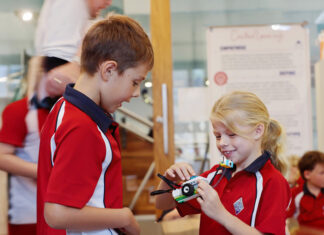By JONATHON HOWARD
NOOSAVILLE residents are worried that a flying-fox colony is being rudely disrupted near Wallace Drive – with calls to “leave the protected species alone”.
One resident, who did not want to be named, said she noticed a huge disturbance of flying-foxes on Thursday, 5 June.
She said hundreds of flying-foxes took to the sky after they were dispersed during the day.
“Once resettled, the flying-fox colony was again disturbed and moved on,” she said.
“So who was responsible?”
Noosa Today made inquiries with Noosa Council in relation to the matter, which was now under investigation by council staff.
Noosa Council’s Environment Officer Peter Milne said council had received unconfirmed reports that some residents might be attempting to disperse the flying fox colony at Wallace Park, Noosaville.
Mr Milne advises that the flying-foxes are protected and any interference requires state and federal approvals.
“It’s a difficult problem, obviously the large number of bats currently in Wallace Park is making life difficult for some residents,” he said.
“Flying foxes are common in the Noosa area, but numbers increased this season, probably in response to flowering melaleuca paperbark trees on the coast.”
Mr Milne said it was normal behaviour for flying-foxes to follow their food sources, however, once the paperbark trees finished flowering it was likely the majority of bats would move on.
Flying-fox colonies were recently shifted from the Sunshine Coast as part of community push to move a colony from Cassia Avenue, Coolum.
Mr Milne said he had heard from two reliable reports that some of the flying-foxes had already returned to Cassia Avenue.
Noosa Council takes a different approach to flying-foxes colonies, preferring to work with the species – considered a vital pollinator within Noosa’s Biosphere.
Flying-fox numbers have also spiked this month due to the melaleuca flowering season, which is considered one of the favourite foods of the species.
Environment Portfolio Sunshine Coast Councillor, Jenny McKay, said a mass flowering of melaleuca trees along coastal lowland areas had attracted groups of flying-foxes from within and outside the Sunshine Coast.
“This increased activity has been occurring in the evening, when the flying-foxes seek nectar from the flowering Melaleuca Trees,” she said.
“Council has received several reports of flying-foxes feeding on trees at night with concerns from some residents of new roosts setting up nearby which is not the case if the activity is occurring at night. Flying-foxes only roost during the day.”
Flying-foxes tend to stay for short durations in trees while they’re feeding at night before returning to their roost site in the early hours of the morning. They play an important role in pollinating native trees such as melaleucas and many of the eucalypts that provide habitat and food for many native parrots and marsupials like gliders and koalas.
Flying-foxes are a protected species and are managed under two pieces of legislation. The three common species of flying-foxes found on the Sunshine Coast – black flying-fox, grey-headed flying-fox and the little red flying-fox – are all protected under the Queensland Nature Conservation Act 1992 and the Commonwealth Environment Protection and Biodiversity Conservation Act 1999.
If you have seen or heard anything about cruelty towards flying-foxes you should contact Noosa Council on: (07) 5329 6500 or report the matter to RSPCA on: 1300 ANIMAL (1300 264 625).
Residents who discover injured flying-foxes should immediately contact Noosa Flying-fox Rescue Release Noosa Inc on 07 5485 3393.






